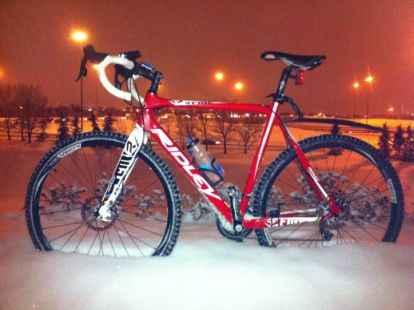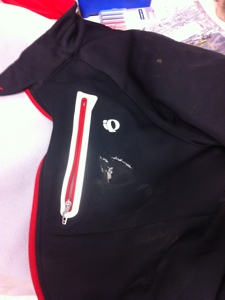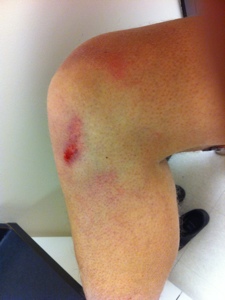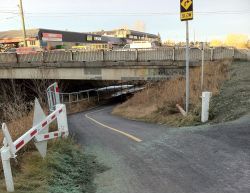The raison d’etre of this space is simple – I had a lot of questions around riding, a healthy cynicism of those standing to make a profit in answering my questions, a need to draw my own conclusions without re-inventing the wheel along the way and desire to share the journey with others who might find themselves with similar questions. If I was going to wear stretchy shorts, there was going to be a reason that didn’t include because they do.
I have attempted to ride through the winter this year with a reasonable amount of success. The mileage hasn’t added up as quickly as the summer, the ride calendar showing big gaps during the coldest periods. There’s little doubt that riding in the winter requires more effort – physical and mental. The biggest mental effort comes off the bike, before the ride begins. Ugh…-15…west wind…cold and windy…I don’t need to ride…it’s going to suck…I’ll be cold… Trying to stay out of that self-defeating space is hard for me. My solution is fairly straight forward –each evening, I lay out all my gear and get everything packed before I look at the forecast for the morning. If it’s been especially cold, I make sure to have the extras within reach so there’s no messing about in the morning. Get up, get the gear on, get the pack on, get out the door. Prudence dictates that a proper look at the current and forecast conditions is done before departure – I don’t need to freeze to death in an attempt to prove how hardy I am – but I don’t have to think about anything and all the work is done.
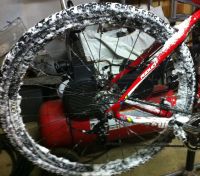
Extra snow = extra training! For Free!
I have however discovered my personal riding hell, that thing most likely to keep me off the bike. Hours after a good snowfall, traffic has trampled the fresh snow into semi-packed tracks and trails along the roads. The snow is thick now, having been compressed by so much traffic, but it is not yet solid. The weight of bike and rider is not enough to press through to get a solid purchase on the packed ice below but we will be pushed around by the varying consistencies of snow density and the icy ruts lurking beneath. The wheels are travelling entirely separate routes from one another as the front end pushes and plows and slides around. This is entertaining enough on flat, quiet roads but degenerates rapidly into abject terror on descents and mortal fear on busy streets. Climbing becomes, quite literally, impossible as the tires, despite their studs, can find no traction to propel the bike through the thick snow and eventually my speed falls below that required to maintain a rubber-down orientation. The last big snow included a perfectly-executed over-the-high-side shoulder roll, a vain attempt at climbing via the sporadically-shovelled sidewalks and a lot of bicycle carrying. The paths were amazingly clear and plowed. The roads? Not so much.
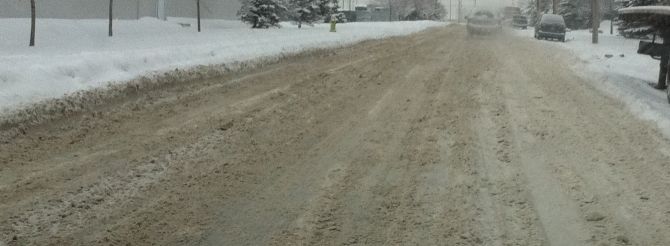
Semi-packed snow, ice-rut foundation, dense and super slick. My version of cycling hell.
So – the how. How do I ride in when it’s snowing and blowing and cold out?
- The biggest thing is simply to do it. Just get on the bike and ride, ignoring that voice screaming all sorts of objections. Ignore people that use words like stupid or idiot. That’s number one.
- Layers – like any other outdoor winter activity, staying warm is all about the layers

Northwaves, lobster mitts, goggles and come cleaning gear.
I was dubious of the Pearl’s ability to keep me warm in Calgary’s winter but it has continued to surprise me, time and again. Those three items – the Merino and two Pearl layers leave me sweating more days than not. My own tendency is to ride hard so I might be warmer than someone riding a little more relaxed. No question that my legs and hips get chilly when it’s really cold. The Roubaix / driWear combination is just not enough to slow down the windchill effect. I’ve got a pair of unlined GoreTex rain pants I’ll try over top the next time I can’t talk myself out of riding when it’s RBC – Really Bleedin’ Cold. The bike – what about the bike? I’ve chosen to continue riding the Ridley through the winter though I’ve been told that’s unfair to the bike. The folks that made it don’t think so:
@forgedcyclist And a nice place to ride your bike! How do you like the X-Fire with discs? *BV
— Ridley Bikes (@Ridley_Bikes) January 22, 2013
but I do expect that grime in the drivetrain will shorten its life.
Luckily – or not – I seem to be much slower in the winter so I rarely get onto the big ring – one less part to worry about changing in the spring. I fully expect to replace the chain, rear sprocket and inner chainring but it’s not like I’m riding Dura-Ace or SRAM RED level components – the parts are relatively inexpensive. I wash the bike regularly, more when the weather is back and forth between freezing and melting (which provides its own set of riding challenges). It’s an opportunity to check the bike over for loose fasteners, damage, chips and so on. It’s also a key piece of extending the life of the drivetrain – washing the grit out of it. For chain lubrication I’ve stayed the course with the usual red-top bottle of Teflon dry lube. Dry attracts less grit and grime and keeps the overall drivetrain cleaner. I scrub the chain down with a brush during its bath until I can handle it without getting dirty. Add one drop of lube per roller, cycle it and let it sit until the next morning, then spend a minute or two back-pedalling the chain through a rag to remove the excess. When it’s wet out, I’ll spray some all-in-one cleaner/ lube onto a rag and give the chain a wipe to keep the surface from rusting.

Studs, but only in the center.
I bought some Nokian IceSpeed studded tires which improved things dramatically but they are not a panacea – they do not replace dry pavement and slicks, nor do they replace common sense. They have no studs on the sides, only the middle, so leaning into an icy turn will not go well. I know this. Otherwise, they provide a healthy amount of winter traction for the conditions I encounter most days, day-after big snow being the major exception. That’s it – other than extra attention paid to the drivetrain and some studded tires, the bike is as-delivered.
There you have it – one man’s recipe for Winter Riding Success. This is not a set of directions to tell you how you should approach riding through the winter. Rather, this is how I managed it. I’ve skipped out on some of the brutally cold days admittedly – I’m good down to -20C, with windchill to -30C but that’s it. The admonishment you’re too old to develop character through athletic feats, a response received when trying to figure out how to ride the semi-packed snow, drove home the awareness that with an entire household depending on me to put food on the table, I don’t need to break my collar bone (or worse) trying to prove to myself how hard-core I am.
I figure if I can do it, anyone can. It takes more prep than going for a quick spin in the summer and getting past the mental obstructions thrown up takes some effort but really, it’s not that hard. Layer up and get out there (or don’t – your call really).
